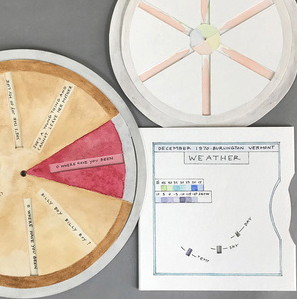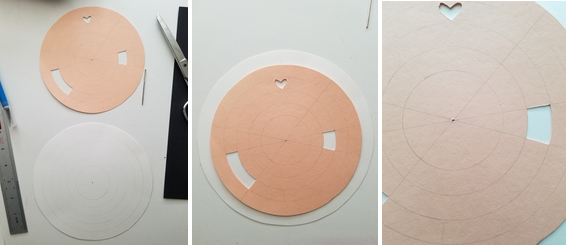Back in January, I was able to participate in a short class on crafting volvelles taught by book artist Stephanie Wolff. She led us through the creation of three different variations on the structure as well as shared examples of how various contemporary artists are using volvelles to convey a wide variety of concepts.
Volvelles, also known as wheel charts, are movable charts that when aligned in certain ways reveal a variety of information as decided by the creator. These were used in the past to communicate important information such as the positions of the sun and moon at certain times of the year, a vital task to many cultures. They were also used as teaching tools for early astronomers and mathematicians, as can be seen in an amazing book held in Collins library’s rare books collection- a copy of The Cosmographia by Peter Apian from 1584! For full disclosure, the first thing I did when I got a chance to peruse it was smell it; how often do you get to smell a book that was created over 400 years ago?! This book was an incredibly important resource of its time for helping people understand the known world and as such was reprinted and improved upon in a number of editions.
The main reason the copy of The Cosmographia belonging to the university’s library is so special is that the volvelles inside are still intact and working. This is rare because they are paper instruments and as such, incredibly fragile to begin with. When you imagine how many hands this book might have encountered in its 400+ years, it is all the more incredible that you can still pick up and work the instruments that students used to understand the workings of the universe as they knew it in 1584. There are three working volvelles in the Cosmographia. They are all unique structures that allowed the students to interact with some of the material being taught in the book. These teaching tools are an incredible reminder that 400 years ago scholars were just as fascinated with understanding the universe they inhabited as we are today.
Another incredible thing to note about these instruments is that they are made from recycled paper- by looking on the backs of the volvelles you can see that they were printed on what were discarded pages of text! It might seem like a little thing, but it is 437 year old evidence of material being thoughtfully repurposed, which is pretty special in my view. A close inspection of the wheels will also reveal that whoever cut the pieces out wasn’t the most precise with scissors and the edges are a bit ragged, further evidence of a human hand’s involvement in the construction of this book, living so long ago.
After viewing these historic volvelles and comparing them to the contemporary artist’s versions I was shown in the class, I am struck by the wide variety of forms they can take and the information they can be used to express. Books have existed in so many forms for thousands of years and it is amazing to know we can still construct and adapt their many styles to meet the needs of artist’s today.
Instructions for making a simple volvelles are as follows:
Step 1 – Cut out 2 circles of different circumference
- Ex. One circle with a circumference of 6 inches and another circle with a circumference of 4 inches
- Using a compass is going to aid you greatly in creating nearly perfect round circles (depending on your cutting skills) but there are no rules in my opinion and you can make a wonky circle if you so choose
- Step 2 – Decide where you will make your cutouts on the topmost circle to reveal the information you choose to put on the bottom circle. You can make this easy and precise by measuring accurate spaces on both the bottom and top circles.
Step 3 – Decorate your volvelle however you see fit, making sure to at least put down all the information you want on the bottom circle before you assemble it in the next step.
Step 4 – To assemble, you will need a needle and sturdy thread – I used waxed bookbinding thread. Tie off a knot at one end and then thread through from the back of the volvelle. Tie off as close to the base as possible. You want a snug fit between the knot and the paper.
– By Kendyl Chasco, Library Assistant, Studio Art ‘22





